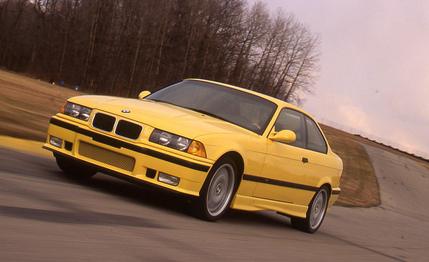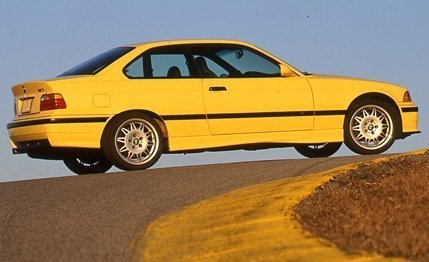
 Archived Road Test
Archived Road Test
Talk about a case of delayed gratification. At first, BMW said we were not going to get the M3 version of its seductive 3-series coupe. Then it said we were, but with the less-than-tantalizing proviso that it would not have the European M3’s engine. Instead, we’d get a modified 325i’s engine. That meant no handmade throttle bodies, no continuously variable valve timing. We couldn’t help having reduced expectations.
Which made our surprise even more pleasant. The U.S M3 is equipped with a bored-and-stroked version of the 325i inline six, but that engine wasn’t exactly bad from the get-go. In M3 trim, now known as the S50, it’s a 3.0-liter with 240 horsepower and 225 pound-feet of torque at its disposal, which it deploys in such a willing, refined and generous fashion that to drive the car is to fall in love with this engine.


The S50 is also a performance bargain. “Our” M3 trades 42 hp for about a $14,000 slice off what the Euro car would have cost had it been brought over as is. In return, we get a fatter torque curve that climbs to 190 pound-feet at just 2400 rpm., and then flattens between 4000 and 5500 where more than 220 pound-feet is permanently on call.
Thus equipped, the U.S. M3 is better suited to the environment it will find itself in. We have no autobahns here. We have very low speed limits here. We have roads that look as if they’ve been on the receiving end of a Serbian mortar assault. And the M3 takes this stuff in stride. A touch of throttle at freeway speeds in the direct-drive fifth gear dials the speed up like a rheostat, jetting the car past slower vehicles in a manner that brings to mind an F-18 cruising through a formation of DC-3s.
Those of us lucky enough to have driven a Euro M3 might notice that the stateside car does not have quite the same exultant rush to the redline that its European cousin has, nor exactly the same surge of acceleration at the top end that 282 horsepower provides. But the U.S. car has, along with the emphatic flow of torque from low down on the tach, a power delivery very much keeping with American driving priorities.


From as low as 2500 rpm, our vivid Dakar-yellow M3 pulled like a turbo car all the way to its engine limiter at 6800 rpm or 6500 rpm, depending on which gear it was in. The engine-management system gives you 6800 in the first two gears, then 6500 in the next two, with a 137 mph cutoff in top. Exactly why our car curtails its rush toward what is surely a 145-to-150-mph top speed is beyond our understanding, although the safety watchdogs are probably scandalized by the 137-mph figure anyway.
Wait until they hear about the way in which the car dashes off easily repeatable 0-to-60 sprints in 5.6 seconds. That's half a second quicker than the company claims for the car. Better yet, it's 0.4 second faster than BMW's claim for the European car. In fact, this car feels so good that comparisons with the Euro car become odious after just a few hours behind the wheel. Not least because the U.S. car is an authentic M-division product, sharing the other M3's unique accouterments.
The body kit is identical, with M-style rocker panels, deep front fascia, and rear under-bumper diffuser, plus unique ten-spoke alloy wheels with ultralow-profile 40-series Michelins. Under the skin, you'll find careful M-division tweaks too. The suspension is a fully redeveloped version of the standard 3-series kit, with reinforced control arms, bushings, and knuckles; gas pressurized shocks; revised spring and bar rates; and massive brake discs.